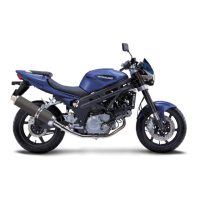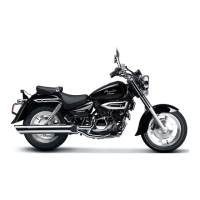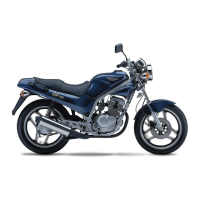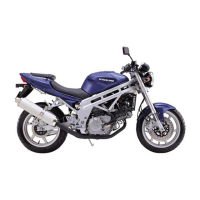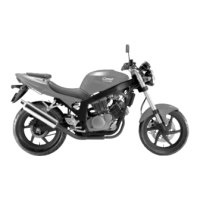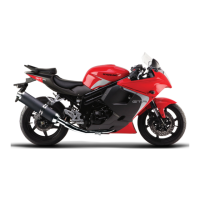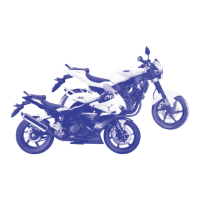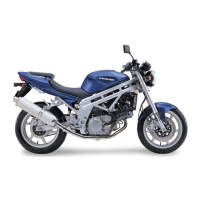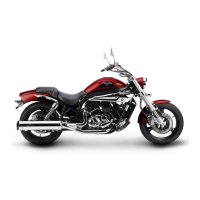Do you have a question about the HYOSUNG GD250 and is the answer not in the manual?
This owner's manual contains important safety information. Please read it carefully.
Information based on latest product data, subject to change without notice.
The first 1,600 km are critical for ensuring maximum life and performance.
Explains the meaning of signal words used in the manual for safety and maintenance.
Essential precautions for safe motorcycle riding for rider and passenger.
Guidelines for selecting and installing accessories to ensure safety and prevent damage.
Locates the frame (VIN) and engine serial numbers for registration and service.
Use unleaded gasoline with an octane rating of 91 or higher.
Recommends oil quality and provides a chart for selecting viscosity based on temperature.
Details required coolant amount and the recommended 50:50 mixture for protection.
Identifies controls and components located on the handlebars.
Identifies various parts of the motorcycle's body and frame.
Explains the functions of the ignition switch in ON, LOCK, and OFF positions.
Explains the meaning of TACHOMETER, FUEL WARNING, FI, COOLANT TEMP, NEUTRAL, HIGH BEAM, and TURN SIGNAL indicators.
Step-by-step guide to setting and adjusting the motorcycle's clock.
Details the operation and safety precautions for the clutch lever and dimmer switch.
Explains the functions of the engine stop switch, front brake lever, and throttle grip.
Instructions on how to adjust the front brake lever position for rider comfort.
Guides on how to properly shift gears, including neutral selection.
Details how to change the footrest position for optimal riding.
Explains how the side stand interlock system prevents starting with the stand down.
Instructions on how to remove and reinstall the front and rear seats.
Information on trunk capacity, heating, and items to avoid storing inside.
Essential safety guidelines and warnings for refueling the motorcycle.
Procedure to check engine oil level using the sight glass.
Specifies the oil quantities for oil change, oil/filter change, and overhaul.
How to inspect and maintain the coolant level in the reservoir tank.
Step-by-step guide and safety checks before starting the engine.
Warnings about excessive speed and maintaining rider control.
Hazards of downshifting at high engine speeds or while leaned.
Guides on how to properly stop the motorcycle and park it safely.
Recommendations for throttle opening during the initial break-in period.
Detailed list of items to check for steering, throttle, brakes, fuel, etc.
Guidelines for regular service intervals and dealer recommendations.
Identifies critical points requiring lubrication for motorcycle longevity and safety.
Lists the tools provided for periodic maintenance and their usage.
Guidelines for safe handling, disconnection, and storage of the motorcycle battery.
Explains how to clean and maintain the air cleaner element for optimal performance.
Details on checking and adjusting the spark plug electrode gap.
Importance of correct throttle cable play for engine idle and rider control.
Procedures for adjusting the clutch cable play at the lever and adjuster.
What to look for when inspecting the drive chain for wear or damage.
Proper methods for cleaning and lubricating the drive chain with O-rings.
How to check the brake fluid level in the master cylinder and replenish if needed.
How to inspect brake pads for wear and potential damage to the brake disk.
Recommended tire pressures for front and rear tires under different riding conditions.
How to identify tire wear using tread indicators and when to replace tires.
Step-by-step guide for removing and installing the front wheel and tire.
General information and precautions for replacing motorcycle lamps.
Explains the purpose of each fuse and the circuits they protect.
Diagnosing and resolving issues when the engine refuses to start.
How to wash the motorcycle safely, avoiding sensitive areas.
Steps for preparing the motorcycle for storage, including fuel, battery, and tires.
Labels highlighting critical safety information for the operator.
Detailed technical specifications for the engine and transmission systems.
Details on electrical components, lamps, and fluid capacities.
This owner's manual contains important safety information. Please read it carefully.
Information based on latest product data, subject to change without notice.
The first 1,600 km are critical for ensuring maximum life and performance.
Explains the meaning of signal words used in the manual for safety and maintenance.
Essential precautions for safe motorcycle riding for rider and passenger.
Guidelines for selecting and installing accessories to ensure safety and prevent damage.
Locates the frame (VIN) and engine serial numbers for registration and service.
Use unleaded gasoline with an octane rating of 91 or higher.
Recommends oil quality and provides a chart for selecting viscosity based on temperature.
Details required coolant amount and the recommended 50:50 mixture for protection.
Identifies controls and components located on the handlebars.
Identifies various parts of the motorcycle's body and frame.
Explains the functions of the ignition switch in ON, LOCK, and OFF positions.
Explains the meaning of TACHOMETER, FUEL WARNING, FI, COOLANT TEMP, NEUTRAL, HIGH BEAM, and TURN SIGNAL indicators.
Step-by-step guide to setting and adjusting the motorcycle's clock.
Details the operation and safety precautions for the clutch lever and dimmer switch.
Explains the functions of the engine stop switch, front brake lever, and throttle grip.
Instructions on how to adjust the front brake lever position for rider comfort.
Guides on how to properly shift gears, including neutral selection.
Details how to change the footrest position for optimal riding.
Explains how the side stand interlock system prevents starting with the stand down.
Instructions on how to remove and reinstall the front and rear seats.
Information on trunk capacity, heating, and items to avoid storing inside.
Essential safety guidelines and warnings for refueling the motorcycle.
Procedure to check engine oil level using the sight glass.
Specifies the oil quantities for oil change, oil/filter change, and overhaul.
How to inspect and maintain the coolant level in the reservoir tank.
Step-by-step guide and safety checks before starting the engine.
Warnings about excessive speed and maintaining rider control.
Hazards of downshifting at high engine speeds or while leaned.
Guides on how to properly stop the motorcycle and park it safely.
Recommendations for throttle opening during the initial break-in period.
Detailed list of items to check for steering, throttle, brakes, fuel, etc.
Guidelines for regular service intervals and dealer recommendations.
Identifies critical points requiring lubrication for motorcycle longevity and safety.
Lists the tools provided for periodic maintenance and their usage.
Guidelines for safe handling, disconnection, and storage of the motorcycle battery.
Explains how to clean and maintain the air cleaner element for optimal performance.
Details on checking and adjusting the spark plug electrode gap.
Importance of correct throttle cable play for engine idle and rider control.
Procedures for adjusting the clutch cable play at the lever and adjuster.
What to look for when inspecting the drive chain for wear or damage.
Proper methods for cleaning and lubricating the drive chain with O-rings.
How to check the brake fluid level in the master cylinder and replenish if needed.
How to inspect brake pads for wear and potential damage to the brake disk.
Recommended tire pressures for front and rear tires under different riding conditions.
How to identify tire wear using tread indicators and when to replace tires.
Step-by-step guide for removing and installing the front wheel and tire.
General information and precautions for replacing motorcycle lamps.
Explains the purpose of each fuse and the circuits they protect.
Diagnosing and resolving issues when the engine refuses to start.
How to wash the motorcycle safely, avoiding sensitive areas.
Steps for preparing the motorcycle for storage, including fuel, battery, and tires.
Labels highlighting critical safety information for the operator.
Detailed technical specifications for the engine and transmission systems.
Details on electrical components, lamps, and fluid capacities.
| Displacement | 249 cc |
|---|---|
| Fuel System | Fuel injection |
| Cooling System | Liquid Cooled |
| Front Suspension | Telescopic fork |
| Rear Suspension | Mono Shock |
| Front Brake | Single disc |
| Rear Brake | Single disc |
| Engine Type | Single cylinder, 4-stroke |
| Weight | 155 kg (Dry) |
